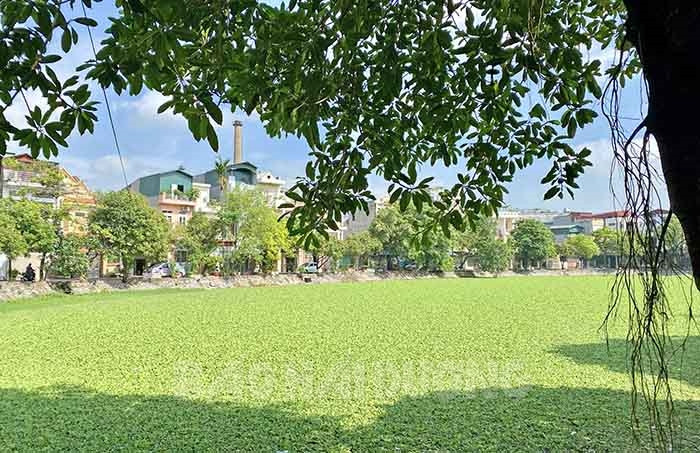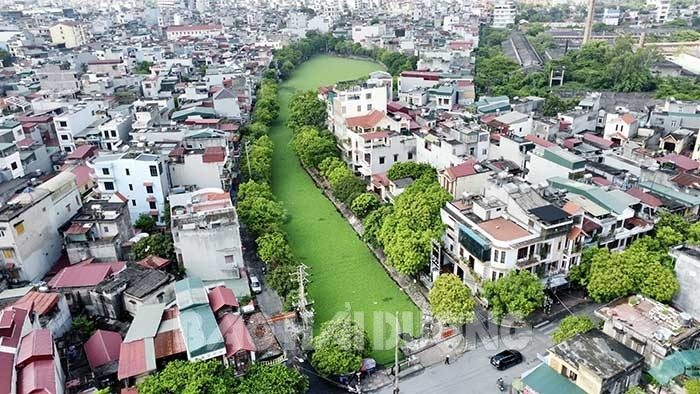Although there are almost no traces left, Thanh Dong is always mentioned as a part of the history of Hai Duong city today, of which the moat is an inseparable part.

Water fern covers the moat and acts as a "water filtration plant".
Historical sources recording the moat of Hai Duong city are very few, but all confirm that this is a canal system surrounding and protecting Thanh Dong more than 2 centuries ago.
The few remaining traces
In the process of searching for documents about the citadel, we found very few related documents. The "Dictionary of Hai Duong Streets" of the Advisory Council for Naming Roads, Streets and Public Works of Hai Duong Province is a rather thick document when describing the history of each street, each road of Hai Duong City, but it only mentioned the citadel in just over 100 words. Meanwhile, we also do not have "Hai Duong scholars" who specialize in researching and collecting in-depth information about the city's history.
Hao Thanh is a canal system that surrounds and protects Thanh Dong. A remaining section of that canal system, after more than 2 centuries, has been named Hao Thanh Street. Hao Thanh Street is currently located in Pham Ngu Lao Ward, the starting point of the street meets Tue Tinh Street near Military Hospital 7, the ending point meets Pham Ngu Lao Street at Cong Trang, which was previously narrow, only enough for rudimentary vehicles to pass. Hao Thanh was named in Decision No. 27/2009/QD-UBND dated September 21, 2009 of Hai Duong Provincial People's Committee. The street is 400 m long and 7.5 m wide.
Where is Thanh Dong and why is the citadel located here? The book “Geography of Hai Duong City” writes: Before 1804, Hai Duong’s headquarters was located in Lac Thien (today’s Chi Linh City) and was called Thanh Van or Doanh Van. Later, from Lac Thien, Hai Duong’s headquarters was moved to Mao Dien (Cam Dien Commune, Cam Giang) today.
In 1804, King Gia Long decided to move the Hai Duong citadel from Mao Dien to the east (towards the East Sea) 15 km, at the confluence of Ke Sat River and Thai Binh River, in the area of 3 communes Han Giang, Han Thuong and Binh Lao. This was the year Dong Citadel was established. The Hai Duong governor at that time, Mr. Tran Cong Hien, was assigned the task of organizing the move of the citadel and building Hai Duong Citadel. The citadel was also called Dong Citadel, because it occupied a strategic position to the east of Thang Long Citadel, blocking the enemy from entering from the sea.
In the past, the Eastern Citadel was connected to the outside by a moat system 11 truong (about 44 m) wide and 6 thuoc (2.4 m) deep, connecting to the Ke Sat River via the Ba Cua sluice (on present-day An Ninh Street) and the Han Giang River (now the Thai Binh River). This waterway traffic system helped the military and officials in the Eastern Citadel to supply and transport food and weapons. Over time, the current moat has narrowed in both depth and width.
In 1883, the Eastern Citadel fell into the hands of the French colonialists. By the beginning of the 20th century, it was almost completely destroyed, but it was determined that the citadel had 4 gates: east - west - south - north. The east gate is located near the current Hai Duong Provincial Post Office, the west gate is located on Tue Tinh Street near Military Hospital 7, the south gate is near the main gate of Hai Duong Provincial Police on Ho Chi Minh Avenue, and the north gate is located on Chi Lang Street.
Although there are almost no traces of the Eastern Citadel, with the assumption that the citadel had four gates, the current Hao Thanh street could be located at the western gate. Thus, the current Hao Thanh street could have been formed at the same time as the Eastern Citadel was established, when the governor Tran Cong Hien moved his headquarters here to build the citadel. At that time, it could have been a protective canal section to the west of the Eastern Citadel.

Seen from above, Hao Thanh is a street with many trees in the heart of Hai Duong city.
Unique features of Hao Thanh street
Lying along both sides of a moat of the ancient Thanh Dong, which later became the street name, has made Hao Thanh a unique street in Hai Duong city today.
This is the only street in Hai Duong City that runs around the moat. If you drive from one side to the other, you have to go in a circle, because cars are only allowed to go one way on this street. Hao Thanh is also a street shaded by green trees such as tamarind, longan, jackfruit, and banyan trees... Interspersed between the households on both sides of the street are many famous food and beverage shops such as pho, bun cha, and sea snails...
Previously, the water surface in the middle of Hao Thanh street was heavily polluted, but now the situation has improved significantly, especially when water fern was brought to grow green on the moat and act as a "water filtration plant", preventing foul odors. The moat has been surrounded by solid stone embankments, becoming a pedestrian area for the people around.
Although the East Citadel has almost no traces left, for many people, it has become an indispensable part of the history of Hai Duong City. It is also a historical work associated with this land since its inception, during the process of building, protecting and constructing, to have a modern Hai Duong City today. In which, the citadel is an inseparable element.
TIEN HUY